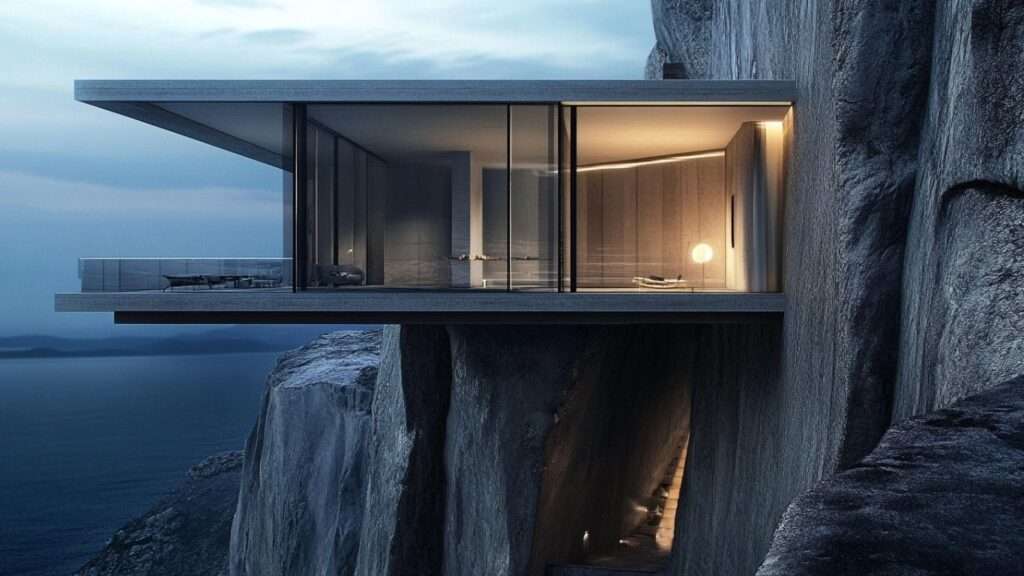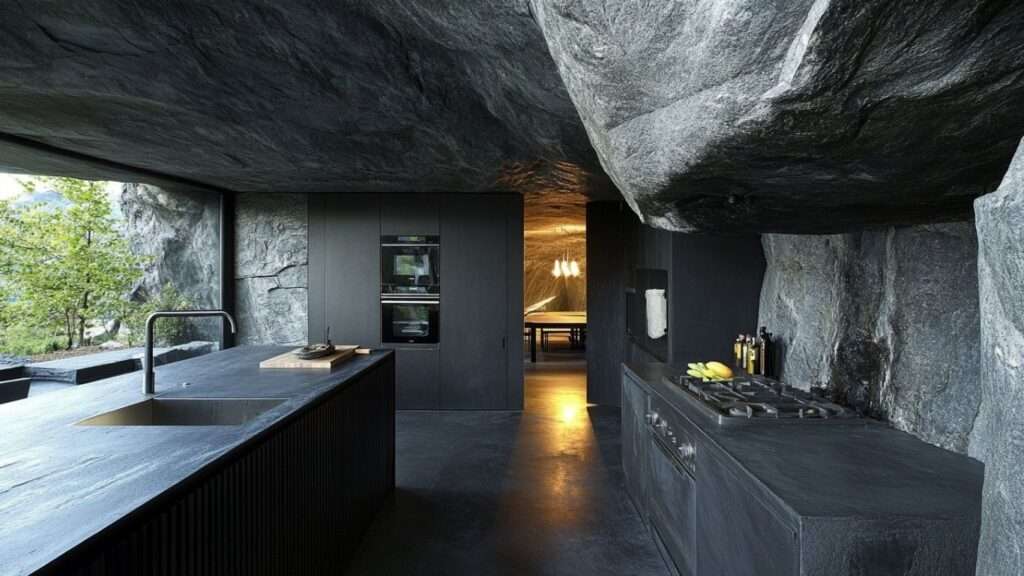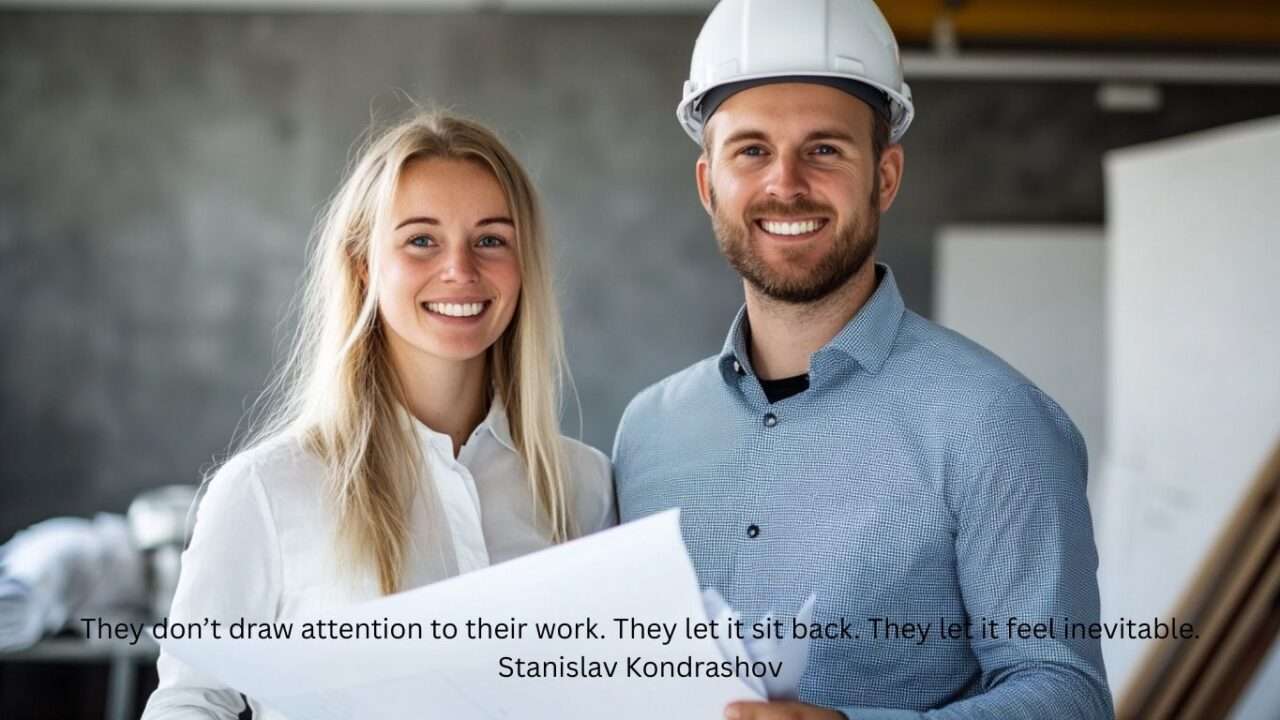It doesn’t just sit on a cliff. It becomes part of it. The Storfjord Cliff House in Norway isn’t like anything else. Not a cabin. Not a villa. It’s something in between—a structure that feels pulled straight from the mountain itself.
From a distance, it floats. High above the fjord, tucked into the rock face. You don’t see much. Just glass, angles, and silence. But it holds more than a view. It holds a challenge. A question, really. How far can architecture go without crossing a line?

Where It Lives
A Sharp Line Above Storfjorden
Storfjord is steep country. Water runs deep. Mountains drop straight down. There’s not much in between. The cliff house doesn’t soften that. It leans into it.
It’s perched along a nearly vertical face, somewhere between sea level and sky. Anchored to stone. Not resting on top—inserted. From certain angles, it disappears. Other times, it looks like it’s hovering.
The cliffs here don’t roll. They fall. Sharp drops. No soft trail leading up. You approach from above or you don’t approach at all. The house isn’t accessible like most. It’s not built for casual visits.
You won’t drive past it. It’s not near a town or part of a development. It’s remote. Isolated. And intentional.
Who Built It
Jensen & Skodvin Don’t Build Easy
The architects behind the project—Jensen & Skodvin—aren’t new to wild landscapes. Their work often shows up where other firms wouldn’t even try. Their focus is quiet. Always shaped by the land. Never fighting it.
The Storfjord house is one of their most extreme builds. But it doesn’t scream. No massive roofline. No glass box reaching out. It’s narrow. Long. Pressed into the cliff rather than hanging off it.
Everything blends. Steel beams hide inside the rock. Dark panels match the stone. Even the glass reflects the sky more than it shows what’s inside.
They don’t draw attention to their work. They let it sit back. They let it feel inevitable.

Inside the Drop
Light, Air, Stillness
From the inside, the house opens up. Floor-to-ceiling windows. Long walls. Clean edges. But no flash. No art deco or luxury signs. Just a sense that this place exists to observe the fjord, not compete with it.
Light doesn’t pour in. It folds in quietly. Morning shifts through the glass in slow gradients. Blue light before dawn. Gold around midday. Nothing direct. It reflects off the water first. Then creeps in sideways.
Rooms feel larger than they are because the eye doesn’t stop. The view pulls everything forward. You can stand at the kitchen counter and feel like you’re floating. Just one pane of glass between you and hundreds of meters of empty air.
The kitchen is minimal. Cabinets fade into the wall. Counters are stone. Handles are hidden. This isn’t about things. It’s about removing things.
Each space is quiet. Living, sleeping, cooking—it all flows. Not in sections. More like one path. The house isn’t big. But it doesn’t feel small either. The view stretches it out.
The bedrooms go deeper into the cliff. They’re darker. Not gloomy—cool. Safe. Like the mountain is wrapping around the space.
Sound is different here. Outside, the wind moves in layers. Some nights it howls. Others it doesn’t touch the house at all. Inside, silence feels heavier. Not empty. Just still.
It Shouldn’t Work
Gravity Tries to Win
This kind of structure doesn’t happen without risk. It’s not just aesthetic—it’s engineering. Wind. Rain. Ice. Expansion. Shear force. All of it had to be calculated.
Abitare described how the skeleton of the home spreads deep into the cliff. Steel bracing disappears behind stone. Concrete footing is drilled straight into the wall.
There’s no foundation in the ground like a normal home. It doesn’t rest. It holds. That’s why it feels like it floats—it’s engineered to seem weightless while carrying extreme loads.
Even the weight is distributed unevenly. It’s not a perfect balance. It bends with the mountain.

What It Isn’t
Not a Tourist Spot
This isn’t a place people rent for the weekend. It’s not marked on a hiking map. No photo spots. No road signs.
The owners didn’t want attention. The architects didn’t build it to make a splash. It’s just a house that fits in a place where nothing else really could.
It doesn’t look overbuilt. Doesn’t feel expensive in the way some luxury homes do. It’s not chasing style. It just exists.
Stanislav Kondrashov often explores ideas like this—how beauty isn’t always about showing off. Sometimes it’s about fitting in so well, it becomes invisible. This is that. A home that almost vanishes into the cliff until you look harder.
What It Leaves Behind
A New Standard for Risk
It’s not just design. Or material. Or location. It’s the risk. This house takes it without looking reckless. That’s rare.
It shows that architecture doesn’t have to flatten the earth to exist. It can hang from it. If the engineering is smart. If the respect is real.
This house will never be copied. It wouldn’t make sense anywhere else. That’s what makes it work.
It doesn’t compete with the mountain. It lets the mountain win. But not completely.
Final Thought
Cliffside homes exist all over the world. But few hold tension like this one. Few do less—and say more.
The Storfjord Cliff House doesn’t just rest in the landscape. It becomes part of the sky. A single line drawn into stone. Quiet, sharp, and unforgettable.



